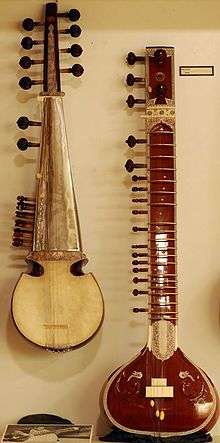Dholki
| Other names | Dholki |
|---|---|
| Classification | Musical instrument |
The Dholki (Marathi: ढोलकी) is a South Asian two-headed hand-drum. It is also known as Nal. It screw-turnbuckle tensioning on both sides. This is longer than Dholak and having lesser diameter. The Dholki is mainly a folk instrument, lacking the exact tuning and playing techniques of the tabla or the pakhawaj. The drum is pitched, depending on size, with an interval of perhaps a perfect fourth or perfect fifth between the two heads. This is the instrument used for high pitch music.[1]
Construction
The left side resembles the bayan (large metal drum of the tabla) except that it usesdholak masala (oil based application) on the inner surface instead of a syahi (permanent black spot). The right head is unique in its construction. Goat-skin is stitched onto an iron ring. In the centre of this skin is a syahi, similar to tabla except much thinner. The traditional nals were laced with rope and had sticks to function as turnbuckles. Today, metal turnbuckles have replaced the rope lacing in most models. The nal is very popular in the tamasha(street performance) of Maharashtra. It has been absorbed into the Hindi film industry and today the nal is very popular for filmi music. There is often some confusion concerning the term "dholki" because, this term literally means, "a small dholak"; as such, the term is often used for smaller dhalaks that structurally are dissimilar to the nal. The smaller surface of the Dholki is made of skin for sharp notes and the bigger surface is made of other skin for low pitches, which allows a combination of bass and treble with rhythmic high and low pitches.[2][3][4]
Dholki is similar to the Dholak as the heads are a bit more developed. The Bass head is designed more like a tabla head with multi layered skins the paste is still on the inside of the bass head on the treble head side, there is visible paste applied on the outside of the head similar to the table giving this drum for nice high pitched tone reminiscent to a high pitched tabla drum although not as resonant. The combination of the bass and treble tones is very pleasing. The heads are kept in place by metal hooks that have nuts at the bottom that can be tightened or loosened to adjust the pitch of the head. This makes changing the heads very quick. It is required to take caution while tuning as it is very easy to tighten the nuts too much resulting in head breakage. The Dholki's higher-pitched head is a simple membrane while the bass head, played usually with the left hand, has a compound syahi to lower the pitch and enable the typical Dholki sliding sound ("giss" or "gissa"), often the caked residue of mustard oil pressing, to which some sand and oil or tar may be added. [5]
Usage
It is widely used in lavani and Marathi film music. Like the dholak, this drum is also used more in the folk, filmi, bhajan, keertan setting. It is mostly used in India. Dholki is used in all sorts on musical programs.
Usage in Lavani
Lavani is a combination of traditional song and dance, which particularly performed to the beats of Dholki which is a percussion instrument. Lavani is noted for its powerful rhythm. Lavani has contributed substantially to the development of Marathi folk theatre with the help of Dholko [6] The Marathi music in 60s and 70s was widely dominated by Lavani where Dholki was most common instrument used.
Playing style
The drum is either played on the player's lap or, while standing, slung from the shoulder or waist or pressed down with one knee while sitting on the floor. Dholki masters are often adept at singing or chanting and may provide a primary entertainment or lead drumming for a dance troupe. Perhaps the most characteristic rhythm played on the dhol is a quick double-dotted figure that may be counted in rhythmic solfege as "ONE -tah and -tah TWO -tah and -tah THREE-E -TAH, FOUR AND" (rest on "and") or simply a long string of double-dotted notes, over which the bass side is used for improvisation. At the beginning of lavani a piece of Dholki is played for a few minutes.
See also
References
- ↑ Dholki
- ↑ Courtney, David. "Dholki - North Indian Hand Drum". Chandrakantha.com. Retrieved 2016-02-13.
- ↑ "Dholki Sounds pi". Soundsnap.com. Retrieved 2013-03-03.
- ↑ "Information about Dholki, Indian Percussion Instrument". Dholki.com. Retrieved 2013-03-03.
- ↑ Repairing of musical instruments
- ↑ The Encyclopaedia Of Indian Literature (Volume Two) (Devraj To Jyoti), Volume 2 By Amaresh Datta,p 1304
